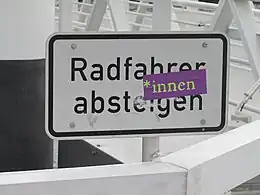Gender star
| Part of a series on |
| Linguistics |
|---|
|
|

The gender star (German: Gendersternchen) is a nonstandard typographic convention used in gender neutral language in modern forms of German.[1] It is formed by placing an asterisk after the stem and appending the feminine plural suffix "-innen". For example, Fahrer ([male] driver) becomes Fahrer*innen (drivers). The gender star makes it possible to refer to all genders while also including non-binary people.[2]
Alternatives to the gender star include Binnen-I, the gender gap (where an underscore takes the place of the asterisk) or using inherently gender neutral terms, such as 'people' instead of 'man' or 'woman'.[3] The gender star was named the German Anglicism of the Year in 2018 by the Leibniz-Institut für Deutsche Sprache.[4]
Pronunciation
In speech, the gender star is sometimes signaled by a glottal stop.[5][6]
Usage
The use of the gender star can be traced back to 2013.[7] It has been used by the Berlin Senate since 2017,[8] and the German Green Party since 2015.[9][10]
Response
In 2019, the Association for German Language launched a petition against the use of the gender star, saying it was a "destructive intrusion" into the German language and created "ridiculous linguistic structures". It was signed by over 100 writers and scholars.[11] Luise F. Pusch, a German feminist linguist, criticises the gender star as it still makes women the 'second choice' by the use of the feminine suffix.[12]
In 2020, the Association for the German Language declared Gendersternchen to be one of the 10 German Words of the Year.[13]
See also
References
- Loxton, Rachel (1 November 2019). "From Fräulein to the gender star: Germany's language revolution". The Local. Retrieved 5 April 2020.
- Berger, Miriam (15 December 2019). "A guide to how gender-neutral language is developing around the world". The Washington Post. Retrieved 5 April 2020.
- Walser, Franziska (September 2019). "Gender: how fair is the German language?". Alumniportal Deutschland. Retrieved 5 April 2020.
- "Anglizismus des Jahres 2018". Leibniz-Institut für Deutsche Sprache. Retrieved 5 April 2020.
- Bukenberger, Carina (22 January 2020). "Wie spricht man einen Genderstern?". Leonarto (in German). Retrieved 5 April 2020.
- Stefanowitsch, Anatol (9 June 2018). "Gendergap und Gendersternchen in der gesprochenen Sprache". Sprachlog.de (in German). Retrieved 5 April 2020.
- Johnson, Ian (7 March 2019). "Gender neutral wording is making German ridiculous, asserts association". Deutsche Welle. Retrieved 5 April 2020.
- Steinhauer, Anja; Diewald, Gabriele (1 October 2017). Richtig gendern: Wie Sie angemessen und verständlich schreiben [Gendering correctly: How to Write Appropriately and Understandably]. Berlin: Bibliographisches Institut Duden. p. 46. ISBN 978-3-411-91250-6. OCLC 1011112208.
- Meiritz, Annett (18 November 2015). "Grüne wollen den Gender-* ganz groß rausbringen". Der Spiegel (in German). Retrieved 5 April 2020.
- Riese, Dinah (19 November 2015). "Die Grünen und der Gender-Star: Mehr als nur Mann und Frau". Die Tageszeitung. Retrieved 5 April 2020.
- "Der Aufruf und seine Erstunterzeichner". Verein Deutsche Sprache (in German). 6 March 2019. Retrieved 5 April 2020.
- Schlüter, Nadja (22 April 2019). "„Das Gendersternchen ist nicht die richtige Lösung"". Jetzt.de (in German). Retrieved 5 April 2020.
- "GfdS Wort des Jahres" (in German). Retrieved 13 December 2020.